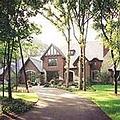 伊利諾州肯尼郡日內瓦鎮的米爾快克(Mill Creek)分部,是一個1500英畝(約合607公頃)混合用途的社區,興建成為一個保育設計開發案例。這個分部是以群集開發的方式建築,它利用沼澤的開放地來引流及處理暴雨積水,不透水表面區域比傳統社區開發方式要少。
伊利諾州肯尼郡日內瓦鎮的米爾快克(Mill Creek)分部,是一個1500英畝(約合607公頃)混合用途的社區,興建成為一個保育設計開發案例。這個分部是以群集開發的方式建築,它利用沼澤的開放地來引流及處理暴雨積水,不透水表面區域比傳統社區開發方式要少。
比起傳統的社區開發方式,這個用於米爾快克的保育地設計技術,使每塊區域大約節省了3411美元。所節省的費用有將近70%是來自處理暴雨積水所減少的成本,而有28%是來自建築場址整地所省下的費用。
米爾快克是17個低衝擊性開發成本與益處的研究個案之一,這種開發方式在美國環保署「非點源控制分部」(Nonpoint Source Control Branch)1月8日所發表的新報告中有相關描述。
該報告以美國及加拿大的例子描述,「以低衝擊性開發(Low Impact Development,LID)策略及施作原則減少暴雨積水的花費」顯示在大多數個案裡,採用適當的低衝擊性開發可以為開發者、資產所有人及社區省錢,同時也保護及回復水質。
低衝擊性開發施作原則試圖管理都市裡從源頭流下的暴雨積水,它的目標是用一個設計好的技術,來模擬一個地方未開發前水的逕流方式,這些技術包括滲透、蒸散、及在靠近逕流水源頭處回收使用。
一些常見的低衝擊性開發施作方式包括雨水花園、草溝(grassed swales)、屋頂儲水器(cisterns)、集雨桶、透水地磚、及屋簷綠化。低衝擊性開發在全美逐漸地被許多社區採用來協助保護及回復用水品質。
The Mill Creek subdivision in the town of Geneva, Kane County, Illinois is a 1,500-acre, mixed use community built as a conservation design development. The subdivision was built using cluster development. It uses open swales for stormwater conveyance and treatment, and it has a lower percentage of impervious surface than conventional developments.
When compared with the conventional development, the conservation site design techniques used at Mill Creek saved approximately $3,411 per lot. Nearly 70 percent of these savings resulted from reduced costs for stormwater management, and 28 percent of the savings were found in reduced costs for site preparation.
Mill Creek is one of 17 case studies of low impact development costs and benefits featured in a new report released Tuesday by the of the U.S. Environmental Protection Agency.
Using U.S. and Canadian examples, the report, "Reducing Stormwater Costs through Low Impact Development (LID) Strategies and Practices," shows that in the vast majority of cases, implementing well-chosen LID practices saves money for developers, property owners, and communities while protecting and restoring water quality.
LID practices are intended to manage urban stormwater runoff at its source. The goal is to mimic the way water moved through an area before it was developed by using design techniques that infiltrate, evapotranspirate, and reuse runoff close to its source.
Some common LID practices include rain gardens, grassed swales, cisterns, rain barrels, permeable pavements and green roofs. LID practices increasingly are used by communities across the country to help protect and restore water quality.
全文及圖片詳見:ENS


